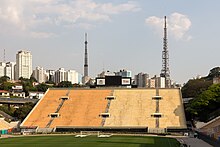Pacaembu Stadium
This article's factual accuracy may be compromised due to out-of-date information. (November 2023) |
This article is missing information about renovation. (November 2023) |
Pacaembu | |
 | |
 | |
| Full name | Estádio Municipal Paulo Machado de Carvalho |
|---|---|
| Location | São Paulo, SP, Brazil |
| Coordinates | 23°32′55.1″S 46°39′54.4″W / 23.548639°S 46.665111°W |
| Public transit | |
| Owner | São Paulo Municipality |
| Operator | Allegra Pacaembu |
| Genre(s) | Art Deco |
| Capacity | 40,199[2] |
| Record attendance | 71,281 (Corinthians 3–3 São Paulo, 24 May 1942) |
| Field size | 105 by 68 metres (114.8 yd × 74.4 yd) |
| Surface | Natural grass |
| Construction | |
| Broke ground | 17 September 1938 |
| Built | 1938–1940 |
| Opened | 27 April 1940 |
| Renovated | 2007, 2021–present |
| Expanded | 1958 and 1970 |
| Architect | Escritório Técnico Ramos de Azevedo - Severo e Villares[1] |
Estádio Municipal Paulo Machado de Carvalho, colloquially known as Estádio do Pacaembu (Portuguese pronunciation:
The stadium is named after
Pacaembu is frequently used to host home matches of the Big 4 football clubs of the State of São Paulo, of which
History
This section needs additional citations for verification. (October 2020) |


The first match ever played at Pacaembu Stadium took place on 27 April 1940, when
On 4 May 1940, the Taça Cidade de São Paulo Final was played at Pacaembu Stadium. Palestra Itália beat Corinthians 2–1, becoming the first club to win a competition at the stadium.
The stadium's attendance record currently stands at 71,281, set on 24 May 1942, when Corinthians and São Paulo drew 3–3.
On 20 September 1942, Palmeiras played its first match after changing its name from Palestra Itália. Palmeiras beat São Paulo 3–1, winning that year's Campeonato Paulista.
In 1945, São Paulo beat Jabaquara 12–1 at Pacaembu Stadium. This remains the highest-scoring match in the stadium's history.
In 2005, the stadium served as the first "Pit Stop" of The Amazing Race 9.
On 11 May 2007,
Until the opening of Arena Corinthians in 2014, Corinthians played most of their home matches at Pacaembu, since their original stadium did not meet the requirements for hosting official football matches.
Between July 2010 and November 2014, the stadium was the temporary home ground of Palmeiras while Allianz Parque was under construction.
Reconstruction
This section needs expansion. You can help by adding to it. (November 2023) |
1950 FIFA World Cup
Six 1950 FIFA World Cup matches were played at Estádio do Pacaembu, which were:
| Date | Time | Team #1 | Res. | Team #2 | Round | Spectators |
|---|---|---|---|---|---|---|
| 25 June 1950 | 15.00 | 3–2 | Group 3 | ~50,000 | ||
| 28 June 1950 | 15.00 | 2–2 | Group 1 | ~42,000 | ||
| 2 July 1950 | 15.00 | 2–0 | Group 3 | ~26,000 | ||
| 9 July 1950 | 15.00 | 2–2 | Final Round | ~44,000 | ||
| 13 July 1950 | 15.00 | 3–2 | ~8,000 | |||
| 16 July 1950 | 15.00 | 3–1 | ~11,000 |
Concerts
This section needs additional citations for verification. (October 2020) |

- Paul McCartney performed in front of 45,000 fans in 1993, during his New World Tour.
- On January 27, 28 and 30, 1995, the Rolling Stonesperformed three sold-out concerts at Pacaembu, to a total audience of 170,000 people.
- The By The Way Tour.
- Bonez Tourmade a stop here, in front of 40,000 fans.
- Eric Clapton performed in front of 60,000 fans in 2001, during his Reptile World Tour.
- Brazilian singer Roberto Carlos performed at the stadium in a 2001 concert.
- Heavy metal band Iron Maiden has made two stops at the venue: in 1996 and 2004 each time performing for 60,000 fans.
- Pearl Jam 2005 North American/Latin American Tourin front of more than 80,000 fans.
Museum


On 29 September 2008, the Museu do Futebol (Museum of Football) was inaugurated.[3] It was created to tell the history of Brazilian football.[4] The museum covers 6,900 square metres (1.7 acres), it was built at a cost of R$32.5 million, and is located below the stadium's bleachers.[5] The 680 workers hired to build the museum completed the construction in 13 months.[6]
References
- ^ "About the architecture project" (in Portuguese). São Paulo State Government. Archived from the original on 2011-10-04.
- ^ "CNEF - Cadastro Nacional de Estádios de Futebol" (in Portuguese). 29 October 2017. Retrieved 29 October 2017.
- ^ "Museu do Futebol é inaugurado nesta segunda-feira em São Paulo" (in Portuguese). Correio da Bahia. 2008-09-29. Retrieved 2008-09-28.[permanent dead link]
- ^ "Visitar o Museu do Futebol custará R$ 6" (in Portuguese). Globo Esporte. 2008-09-23. Retrieved 2008-09-28.
- ^ "São Paulo inaugura Museu do Futebol" (in Portuguese). São Paulo state government. 2008-09-29. Archived from the original on 2011-05-22. Retrieved 2008-09-29.
- ^ "Museum honours Brazilian history". FIFA. 2008-09-30. Archived from the original on September 30, 2008. Retrieved 2008-10-03.
- Enciclopédia do Futebol Brasileiro, Volume 2 - Lance, Rio de Janeiro: Aretê Editorial S/A, 2001.
External links
- Santos FC
- Pacaembu (in Portuguese)
- Inauguration (in Portuguese)

